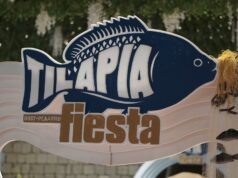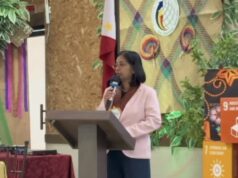Fr. Fernandez shows vessel that will hold relics.
Photos by Bong Z. Lacson
CITY OF SAN FERNANDO – Four hundred and forty years after its foundation, the oldest parish in the province will receive and be the permanent repository of the relics of its patron saint, Augustine of Hippo.
On May 4, the ex ossibus (bone) relics of St. Augustine and his mother St. Monica will be taken in a motorcade from the St. Augustine Parish Church here to the St. Augustine Parish Church in Lubao.
A simultaneous motorcade with relics from the two saints will go to the St. Monica Parish Church in Minalin.
“What more fitting celebration of our 440th year of our parish than in having in our midst the physical presence, if only in relics, of our patron saint and his loving mother,” said Rev. Fr. Noli Fernandez, Lubao parish priest.
Church history says it took buckets of tears and prayers of St. Monica for the wayward Augustine to be converted to the Christian faith where he has since been enshrined as a doctor of the Church.
Lord Francis Musngi, archivist at the Center for Kapampangan Studies, said that the relics of the sainted mother and son, the Lubao church is seen to generate pilgrims praying for their intercession, specially parents with problem children.
“The whole town will certainly be most joyous to welcome and venerate them,” he added.
The municipal government led by Mayor Mylyn Pineda-Cayabyab has linked up with the local church to ascertain a glorious celebration of its birth.
Starting April 26, various activities both social and religious have been laid out, including sports tournaments, cultural and entertainment shows, beauty pageants dances, and Flores de Mayo.
On May 5, Lubao will stage its first Sampaguita Festival to in recognition of the fragrant flower that is a major source of livelihood for the residents.
A solemn high Mass to be concelebrated by San Fernando Archbishop Paciano B. Aniceto, Auxiliary Bishops Roberto Mallari and Pablo Virgilio David and the priests of the six parishes within the town of Lubao will the culminating religious activity on May 5.
The St. Augustine Parish Church was established in 1572 in Barrio Sta. Catalina but was moved to its current site in 1602 due to floods, according to a 1952 marker of the National Historical Commttee.
An Augustinian friar, Fr. Antonio Herrera led the construction of the church from 1614-1630 out of locally made bricks and sand mixed with egg albumen.
The church was occupied by revolutionists in 1898 and used as a hospital by American forces in 1899.
It was destroyed by Japanese shelling in 1942 and was repaired from 1949 to 1952 under Fr. Melencio Garcia.




